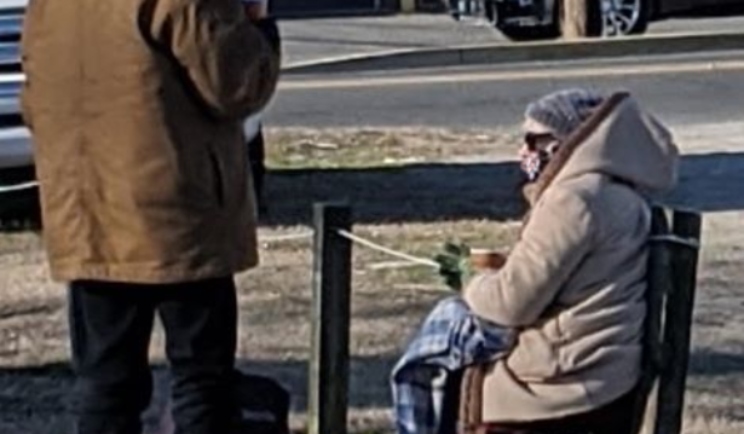EXCLUSIVE | Homeless are dying on the streets of Sussex County

Homeless advocates are calling for additional resources and increased support after two homeless people died on the same night last week in Sussex County, a woman found dead in a tent in Georgetown and a disabled man headed to a shelter who was hit and killed crossing Route 1 in Lewes.
While for some the local homeless population may go unnoticed or even seem invisible, overshadowed by trending news and other issues that are more publicized, but homelessness in Sussex County is a very real issue and it’s growing at an alarming rate.
WGMD’s Rob Petree has learned that at least two people who were homeless died on the streets of Sussex County in the past month.
Most recently, on Friday, Feb. 21, officers with the Georgetown Police Department were called to investigate after a woman was found dead inside a tent within town limits.
“Our officers responded this past Friday morning at about 6:30 a.m., it was a 911 call, and our officers arrived and the patient at that time was found in a tent and confirmed deceased,” Detective Joey Melvin with the Georgetown Police Department explained. “She was transported by the medical examiner and at this time we are still awaiting results, so we can’t speculate as to a cause of death until we get that report back.”
If you speak to homeless advocates such as Jim Martin with The Shepherds Office or Nikki Gonzalez with Code Purple, both will tell you without hesitation that the need for increased resources and support for the homeless has arguably never been greater in Sussex County.
Jim Martin knew the woman who was found dead as she was a regular for bible study and free lunch at the Shepherds Office, a resource and outreach center to assist the homeless population in Georgetown.
“She was found halfway in the tent and halfway out of the tent, almost as if she went out to go to the bathroom and then was trying to get back in there,” Martin said. “What we knew about her was that she would enjoy attending the bible studies that we have on Friday nights. She would share during those group meetings about her hopes, dreams, and prayers.”
Martin said she was a gentle, kind hearted woman who he enjoyed helping and seeing at the Shepherds Office, “she was very gentle in the way that she approached everything.”
While the official cause of death remains unknown at this time pending an autopsy, some are speculating that she may have froze to death, but Martin said from his experiences with her you could tell she was suffering from some sort of underlying health condition.
Martin believes the issue lies with a lack of affordable housing along with severely strained resources and funding to help people break the cycle of homelessness in Sussex County.
In an earlier interview, Martin shared that at least 25 homeless people that he knew of and worked with died over the course of last year in Sussex County.
“Our solution of just letting people die in the streets is not a solution,” Martin said. “We have to provide some kind of shelter for these folks, and most of the people that I work with do want to work, but it’s difficult to work everyday when you have no where to sleep at night and no where to go to the bathroom to get cleaned up and be productive.”
Over in Eastern Sussex County, another homeless person died that very same night, a disabled man who was hit and killed crossing Route 1 headed to a shelter in Lewes.
According to Delaware State Police, the crash occurred shortly after 6 p.m., Feb. 21, as a Chevrolet Tahoe was traveling northbound on Route 1 in the left lane, just south of Route 9. The man was crossing the highway and stepped from the median into the path of the Tahoe. He was pronounced dead at the scene.
Nikki Gonzalez, executive director for Code Purple Sussex County, a non-profit organization that provides resources and emergency shelter for the homeless, knew the man who was killed and said he recently underwent an amputation that affected his walking and possibly contributed to him being hit and killed.
“I knew him well,” Gonzalez said. “He was staying at the Lewes shelter. I’ve known him all the years of Code Purple. He had just had all of his toes amputated and was very unsteady on his feet and I think that may have been a contributing factor to him getting hit and killed on the road last week. It hadn’t been many days since his amputation. Why was he put right on the street with freshly amputated toes, he was in pain and he hobbled.”
Gonzalez and Code Purple Sussex County face a continued battle each season to provide services for the homeless while at the same time struggling with limited resources and a lack of volunteers at its shelters.
When severe snowstorms or sub-zero temperatures are forecast in Delaware, the organizations that manage Code Purple sites activate their shelters. The Code Purple declarations, which vary by county and site, open up additional beds and warm shelter space beyond the year-round shelter beds available across the state.
To be connected to Code Purple resources, visit codepurplesussexcounty.com.
If you see someone outside who appears to be homeless, encourage them to seek emergency shelter or call a non-emergency police number to alert the police to the situation.
For details on shelters and other ways you can get involved to help the homeless, call the Delaware Housing Alliance’s Centralized Intake Line at 1-833-FIND-BED (833-346-3233).


